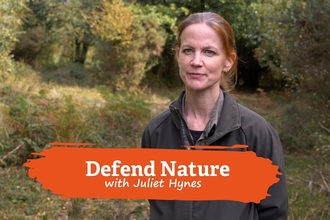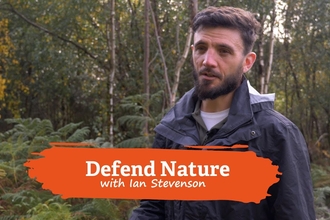There is a lot of contradicting information out there about the latest Government announcements and what their impact on wildlife and our green spaces could be.
On this page, we myth-bust some of the key comments that we've seen in news articles or that have been sent by you from MP and councillor response letters.
“The Government has committed to key environmental targets, some of which are already enshrined in law. These cannot be undone. This now commits us to set the world’s first legal deadline to halt species decline by 2030.”
The Environment Act was the first dedicated environmental legislation for nearly 30 years and the first time England has set legally binding targets for nature’s recovery.
While the Act is a welcome legally binding commitment to halting wildlife decline by 2030, the longer-term targets published don’t provide the ambitious vision for nature’s recovery our Government promised.
Unfortunately, the long-term target currently being proposed for nature’s recovery aims to have just 10% more nature in 2042 than 2030 levels – by which time the state of our natural world is expected to have declined even further.
Read The Wildlife Trusts’ briefing on the Nature Recovery Green Paper and Environment Act target consultations here, published in May 2022.
“This Government will never undermine its commitments to the environment in pursuit of growth. Any reforms will contribute to our economy while meeting our commitments in the 25-Year Environment Plan and the legally binding environmental targets."
In February 2021, the UK Government commissioned the Dasgupta Review which investigated the economics of biodiversity. The Review stated that our economies are embedded within nature and that expanding and enhancing protected areas has an important role to play.
The latest Growth Plan completely disregards the findings of the Dagupta Review. By revoking EU protections and regulations, our landscapes will be left unprotected by those who seek to build infrastructure upon or through it, as well as opening our waterways and putting the air we breathe at risk of even greater pollution.
Join Dr Juliet Hynes, Interim Director for Nature's Recovery, as she breaks down the timeline of Government policy in this short video.
"We published a Nature Recovery Green Paper earlier this year setting out proposals to reform our system of protections, including the Habitats Regulations. We're in the process of analysing responses with our response to be published in due course."
The Nature Recovery Green Paper started a critical debate about how we can recover the health of the natural world, and indeed offered the opportunity to reform and lay the foundations to do so.
The Wildlife & Countryside Link published its progress report on 30x30 in England on 21 October 2022 detailing the progress towards the UK Government's 30% target in England. The report said the Habitats Regulations, which derive from EU environment law, should be the backbone of 30x30. These are being undermined on multiple fronts including by the Retained EU Law Bill.
Just 3.22% of land in England and 8% of the sea is being properly protected and managed for nature according to the report – an alarming lack of progress.
Given that the Retained EU Law Bill only gives until December 2023 for all EU-retained laws to be rewritten or brought into UK law before they are scrapped and how weak the goals of the Environment Act are, it is difficult to see how these won’t be replaced with weaker alternatives.
“I have received reassurance from Defra that the 25-Year Environment Plan remains Government policy.”
The 25-Year Environment Plan was never under threat from the Retained EU Law Bill, as the Environment Plan was put into place by the UK Government, not passed to us via EU laws.
The policies that are under threat are the 570 retained laws that are held by Defra. These laws focus on environmental issues, including key laws like the Conservation of Habitats and Species Regulations, the cornerstone protection for our most treasured sites, and the Water Framework Directives that set strict standards for pollution of rivers. The Air Quality Standards Regulations impose limits for toxic air pollution, whilst the Marine Strategy Regulations ensures the Government protects our seas.
“We’re the only G7 country committed to Net Zero by 2050, have slashed carbon emissions by 45% compared to 1990 levels and are within months of removing coal from the UK energy mix. We also have the largest offshore wind generation capacity in the world."
According to this Government notice, 2021 was the first ever Net Zero G7, where all G7 countries committed to reach net zero carbon emissions by 2050 at the latest. The group also agreed to phase out government funding for fossil fuel projects internationally as well as ending all new finance for coal power by the end of 2021, matched by increased support for clean energy alternatives like solar and wind.
Carbon emissions have indeed fallen - in 2020, net greenhouse gas emissions in the UK were estimated to be 405.5 million tonnes of carbon dioxide equivalent, 49.7% lower than they were in 1990. See the UK Government report here.
One of the biggest contributing factors to this decrease is the phasing out of coal use – the most polluting fossil fuel. While being halfway to our goal of net zero is something to celebrate, from here on in the wins won’t be easy. Net zero means huge declines in the use of coal, oil and gas and huge leaps in clean energy innovation. According to a report by the International Energy Agency, this requires steps such as halting sales of new internal combustion engine passenger cars by 2035 and phasing out all unabated coal and oil power plants by 2040. The deadline to phase out coal from the UK’s energy system has been brought forward to October 2024, two years away, not months. The UK has made a series of deals to keep coal stations in service. National Grid signed an agreement with Uniper to keep the Ratcliffe power station open despite being scheduled to close in September 2022. You can read the press release here. A six-month extension of coal operations has also been agreed by Drax Group and EDF.
“Drax will work with National Grid to source up to approximately 400,000 tonnes of additional coal.”
In terms of offshore wind generation, China does have the largest overall installed capacity in the world, although the UK has made a number of announcements about future offshore wind projects meaning it has the largest capacity pipeline. While this represents a massive scale-up, it nonetheless remains off track from what is required. The UK Government set a target of a four-fold increase in offshore renewable energy by 2030. To achieve this, the Government must double or even triple the rate of offshore wind turbine installations according to a study from Offshore Energies UK.
"The criteria for Investment Zones show that planning policy will only be streamlined in areas which are specifically designed for development to build homes and/or create jobs. Local councils will decide so local people will ultimately have a say."
In Gloucestershire, two Local Planning Authorities (Stroud and Cheltenham) have turned down the opportunity to bid for Investment Zones. In both cases, the reason is in part a concern about the weakening of environmental protections. Other Local Authorities across the country, including our neighbours in Oxfordshire, have done the same.
To increase housebuilding and commercial development, the application form for Investment Zones revealed that councils can apply for Zones in National Parks, Areas of Outstanding Natural Beauty (AONBs), Sites of Special Scientific Interest, (SSSIs) and greenbelt land.
In the expression of interest form, applicants are asked whether the proposed development would be on land which is in:
- A National Park
-
An Area of Outstanding Natural Beauty
-
A SSSI or equivalent designation
-
the buffer zone of a World Heritage Site
-
designated Green Belt
Applicants then have to answer only one question with a yes or no answer on whether they agree to mitigate environmental impacts of the Investment Zone.
There is no mention of environmental constraints on building in protected habitats under the Habitat Regulations, which provide protections for some of the most vulnerable habitats and wildlife in a network across England.
There are many examples of habitats that we can’t pick up and move or rebuild elsewhere. For example, ancient woodlands. Many species that thrive in ancient woodlands are slow to colonise new areas, and the intricate living fungal network that links trees together takes hundreds of years to form.
Analysis by the Woodland Trust found there were more than 125,000 hectares of ancient woodland within the council areas of the 38 authorities who were known initially to have expressed an interest in Investment Zones.
The opportunity for other councils to declare an interest closed on 14 October but the information about how many more have signed up has not been released, so the number under threat could increase




